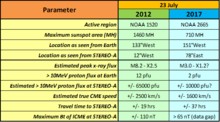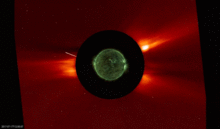news
Submitted on 2017-09-05
The number of clouds hurling through space increased dramatically these last days. There is even one cloud heading into the direction of Earth. Fasten your seat belt.
Submitted on 2017-09-04
In the near future, this duo-satellite will create solar eclipses just like the one we had on August 21 2017, but for more then 7 hours each day!
Submitted on 2017-08-22
PROBA2 did it: it saw the solar eclipse from its 750 km-high seat in space. PROBA2 captured this EUV-image with the moon partly covering the sun.
Submitted on 2017-08-02
On 9 August from 21:30 to 24:00, the Royal Observatory opens its premises to the broad public to observe the night sky. Amateur astronomers will bring their telescopes to allow the participants a view on the stars.
Submitted on 2017-07-27
NOAA 2665 was the source of a spectacular eruption on the Sun's farside on 23 July. A comparison is made with the 2012 event from exactly 5 years ago.
Submitted on 2017-07-19
NOAA 2665 continued to dominate the solar surface and was also responsible for the main event of the week, i.e. a long duration M2 flare associated with a halo coronal mass ejection on the French National Day.
Submitted on 2017-07-10
Solar observers had a great weekend observing and imaging the Sun, in particular with the rather large and dynamic sunspot group NOAA 2665 dominating the solar disk.
Submitted on 2017-07-10
The PROBA2 team welcomes research proposals for the eighth round of its Guest Investigator program for research based on SWAP and LYRA data analysis by scientists outside the SWAP and LYRA PI-teams.
Submitted on 2017-07-04
The Sun surprized solar observers with a medium class solar flare on 3 July. The associated plasma cloud was not directed to Earth.
Submitted on 2017-06-21
A filament eruption and the emergence of a new sunspot group were the main solar events on 14 June.
Pages
Zircon - This is a contributing Drupal Theme
Design by
WeebPal.



















































